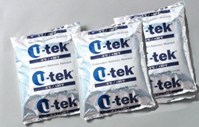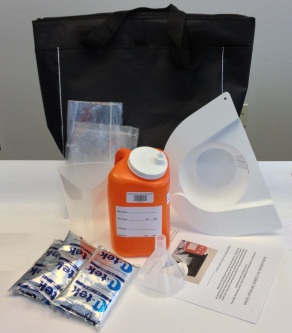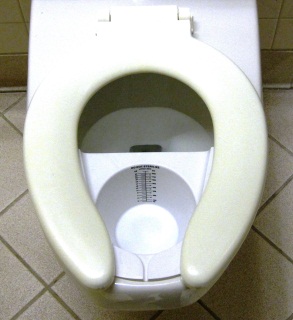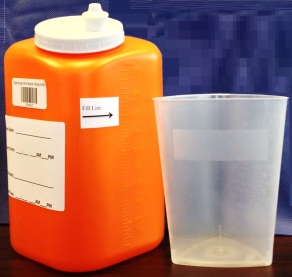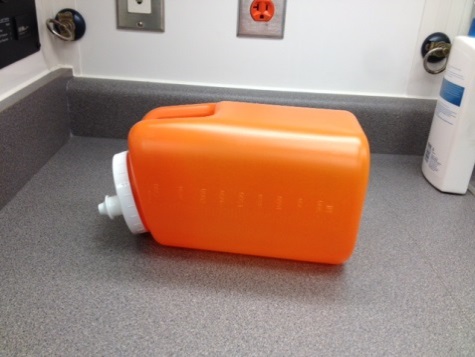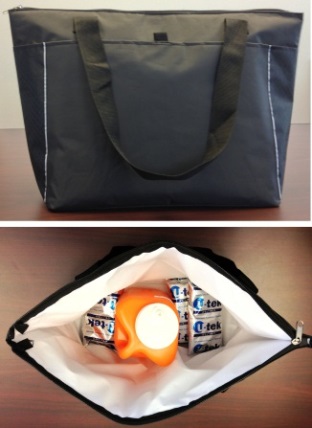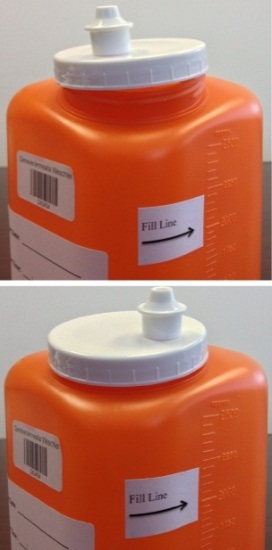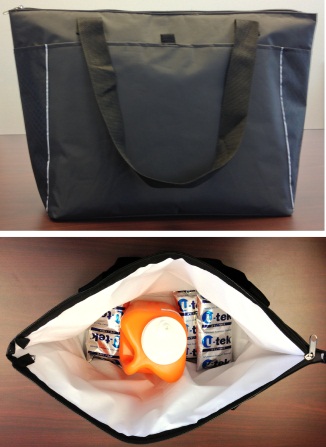Special Studies and Pretests
National Health and Nutrition Examination Survey
Attachment 14-NHANES 24-Hour Urine Collection Protocol
Special Studies and Pretests
OMB: 0920-0950
Attachment 14
24-Hour Urine Collection Protocol
Attachment 14 – 24-Hour Urine Collection
National Health and Nutrition Examination Survey (NHANES)
24-Hour Urine Collection
Study Protocol
October 28, 2013
National Center for Health Statistics, CDC
3311 Toledo Road
Hyattsville, MD 20782
TABLE OF CONTENTS
PROJECT OVERVIEW 3
Title 3
Protocol Summary 3
Investigators and Collaborators 3
INTRODUCTION 4
Background and Justification 4
Objectives 4
PROCEDURES AND METHODS 5
Study Protocol 5
Exclusions 7
Participant Burden for Respondents 7
Consent 7
Risks 7
Laboratory Tests 7
Report of Findings 8
ATTACHMENTS
Attachment A – Randomization Process 9
Attachment B -Suggested Recruitment and Reminder Scripts 11
Attachment C – Written Urine Collection Instructions 14
Attachment D – Verbal Urine Collection Instructions 25
Attachment E – Completion Questionnaire 31
Attachment F – Urine Sample Processing Procedure 36
Attachment G – NHANES Health Measurements List 39
PROJECT OVERVIEW
Title
National Health and Nutrition Examination Survey (NHANES) 24-Hour Urine Collection
Protocol Summary
This proposed component is designed to collect a 24-hour urine sample on a one-half sample of NHANES examinees ages 20-69 in the 2014 NHANES. Half of those who were asked to participate in the 24-hour urine collection component will be asked to collect a second 24-hour urine sample 3-10 days later. The addition of 24-hour urine collection to NHANES will allow us to estimate the prevalence of the U.S. adults who exceed the recommendations for sodium reduction based on the Dietary Guidelines for Americans 2010 which indicate all Americans should reduce their sodium intake to <2300 mg daily and specific subpopulations to <1500 mg daily to prevent Cardiovascular Disease (CVD). These specific subpopulations include African-Americans, individuals with hypertension, diabetes, and chronic kidney disease, and older aged individuals. Please see Attachment A for the detailed randomization protocol.
Investigators and Collaborators
Ana Terry, M.S., R.D.is the Principal Investigator of this proposed component with Vicki L. Burt, Sc.M.as the Co-Investigator. Collaborators for the component include researchers from CDC’s National Center for Chronic Disease Prevention and Health Promotion (Mary Cogswell and Robert Merritt, Division for Heart Disease and Stroke Prevention and Desmund Williams, Division of Diabetes Translation), National Center for Environmental Health (Benjamin Blount), and NIH’s National Heart Lung and Blood Institute (Catherine Loria).
INTRODUCTION
There is compelling evidence indicating that excess dietary sodium intake is detrimental to cardiovascular health (e.g., hypertension, left ventricular hypertrophy, congestive heart failure, excess risk of coronary heart disease, stroke) for almost all population groups regardless of age, ethnicity, sex, or health status. It is important to obtain population baseline data on sodium intake prior to any population based efforts to reduce sodium in the food supply and to monitor trends in intake at the national level subsequent to changes in the food supply.
Background and Justification
The Institute of Medicine, the Pan American Health Organization, and a recently convened National Heart Lung and Blood Institute (NHLBI) expert work group all strongly recommended measurement of 24-hour urinary sodium excretion as the most accurate means of monitoring mean sodium intake in the U.S. population. In addition, NHLBI recommended collecting a second 24-hour urine sample in a subsample of those with one 24-hour urine sample to estimate the population distribution (e.g., proportion of the population who exceeds recommended limits) accounting for day-to-day variation in sodium intake and excretion.
Sodium reduction plays a crucial role in the treatment of hypertension and CVD. Existing NHANES data on prescription medication data, blood pressure, diabetes, CVD and chronic kidney disease in combination with the currently proposed data on 24-hour urine collections can be used to assess whether those with diagnosed hypertension or other chronic diseases have obtained appropriate treatment at the population level.
The major objectives of the component are as follows:
Objectives
The 24-Hour Urine Collection is proposed to be included in the 2014 NHANES to:
Estimate dietary sodium intake in the U.S. population.
Estimate the population distribution of dietary sodium intake (e.g., proportion of the population who exceeds recommended limits).
Estimate 24 hour urine excretion of albumin, urea nitrogen, calcium, oxalate, phytoestrogens, and caffeine metabolites (subject to funding).
Estimate intake of iodine, phosphorus, fluoride, magnesium (subject to funding).
PROCEDURES AND METHODS
This component is planned to be conducted in the 2014 NHANES. Interviewing begins around November 18, 2013 and the 24-hour urine collection should end approximately January 31, 2015.
Study Protocol
NHANES survey statisticians estimate that there will be 2640 examined participants aged 20-69 in the 2014 NHANES. We propose to randomly select half of NHANES non-pregnant participants examined in the mobile examination center (MEC). Of those who collect a 24-hour urine specimen, half will be randomly selected for participation in a follow-up 24-hour urine collection 3-10 days after the first 24-hour urine collection is completed. The second urine collection is proposed to account for day-to-day variation within individuals.
During their MEC examination, participants will be asked to perform a 24-hour urine collection (Attachment B). He/she will be scheduled to return on a different day to a Urine Collection MEC (UMEC) to start the urine collection. Upon arriving for their appointment, a urine collection kit will be given to the participant to use for collecting urine samples over a 24-hour period (Attachment C). The kit will contain instructions on how to collect and return the urine specimen. Survey staff will open the kit, explain the contents, and provide verbal (Attachment D) and written instructions (Attachment C). To start collection, the participant will be asked to empty his or her bladder. Drinking water will be available to help individuals void, if needed. The time of the void is recorded, the urine sample discarded, and the participant is asked to collect all urine from that moment for a period of 24 hours.
Each participant will be randomly assigned to collect the 24-urine samples either on a weekday or on a weekend day. Because, about 60% of appointments occur during the week and in the course of the pilot we were successful in getting urines collected on weekdays, we will randomly ask 60% of participants to collect their urine on a weekday. When the day after the MEC examination is consistent with the randomly assign period of the week (weekday or weekend) we will ask the participant to begin his/her urine collection the following day if possible. If in the course of scheduling the 24-hour urine appointment the participant indicates it is impossible for him/her to collect the specimen during the assigned period of the week (weekday or weekend), he/she will not be excluded from participation but will be allowed to schedule urine collection at his/her convenience.
In addition to starting the 24-hour urine collection in the UMEC, participants will be asked to complete the urine collection in the UMEC that is, return 24 hours later. This return visit appointment will be scheduled at the same time the start collection appointment is made. If the participant can’t come back in 24 hours they must schedule a time within 48 hours of the start of collection to return the urine. It is preferred that participants begin and end the collection in the UMEC, however, individuals’ schedules may not always allow for this. Thus, we have allowed for flexibility by providing instructions on starting and/or ending collection at the UMEC or in the home, depending on participants’ availability.
A set of completion questions will be used to assess the completeness of the urine collection (Attachment E).
A remuneration of $100 will be given to the participant at the end of the questionnaire.
One-half of the participants who successfully completed the first collection will be invited to collect a second 24-hour urine. If the participant agrees, the second 24-hour urine collection will be scheduled 3-10 days later, but not on the same day of the week as the first 24-hour urine collection. If the participant indicates it is impossible to collect the second urine on a different day of the week from the first they will be allowed to collect on the same day of the week as the first collection. Verbal consent will be obtained. The same follow-up questions will be asked upon the completion of the second 24-hour urine collection.
A remuneration of $100 will be given to the participant at the end of second urine collection.
All 24-hour urine collections will be processed as described in Attachment F. The 24-hour urine collection will be assessed for completeness using the Completion Questionnaire. The urine specimen will be considered “incomplete” if:
The start and end time of the collection was not recorded and cannot be ascertained
The length of collection time is <22 hours
The total volume of urine is less than 400 ml
A female participant was menstruating during the urine collection (Item UCQ001, Completion Questionnaire, Attachment E)
More than a few drops of urine were missed during collection (items UCQ002-UCQ008 on Completion Questionnaire, Attachment E)
All urine specimens collected over a period of at least 22 hours which meet other criteria for completeness will be processed (weighed, aliquoted and shipped). NCHS will determine whether specimens collected over a 26+ hour time frame will be included in the analytic sample.
Participants will receive a phone call to remind them of their appointment to start the urine collection (unless their start date is the following day). If a participant does not have a phone where he/she can be reached, an NHANES staff member will make a personal visit to remind them of their appointment to start urine collection.
The 24-hour urine collection and its effects on other post-examination content (telephone dietary recall (DR) that occurs 3-10 days after the NHANES MEC examination and a physical activity monitor (PAM) that is given to participants during the examination and is to be mailed back on the 8th day after the examination) will be monitored by reviewing response rates and reporting to senior management every three months.
Exclusions
Pregnant women and participants who do not respond for themselves will be excluded.
Participant Burden for Respondents
The respondent burden is estimated to be 60 minutes for the first 24-hour urine collection. Additional 60 minutes of respondent burden is estimated for the second 24-hour urine collection.
Consent
Standard NHANES consenting procedures will be followed, with language added to the Health Measurements List (Attachment G): “Select persons (ages 20-69) will be asked to collect their urine for 24 hours.” In addition, verbal consent for the 24-hour urine collection will be obtained.
Risks
There is no more than minimal risk associated with this protocol.
Laboratory Tests
Urinary sodium, potassium, chloride, creatinine, urinary albumin, urea nitrogen, calcium, oxalate, iodine, phosphorus, fluoride, phytoestrogens and caffeine metabolites.
Report of Findings
Currently, results from urine albumin/creatine ratio and estimated glomerular filtration rate are reported to participants. No results from the 24-hour urine collection laboratory tests will be reported. Participants will be given a toll-free number to call if they want to know their results.
Attachment A
Randomization Process
Randomization Process
The selection of the one-half sample of NHANES examinees for the initial collection will be done with the existing NHANES subsample mechanism. That mechanism is based on dividing the Sample Person ID by 20 and selecting one-half of the integer remainders between 0 and 18. Participants whose Sample Person ID has one of those remainders is asked to participate in the 24 hour urine collection. The remainders for the 24-hour subsample collection are: 1, 4, 5, 6, 7, 9, 10, 11, 13, and 18.
The second subsample is carried out on the one-half subsample above and will indicate which participants will be subsampled to do a weekday collection (60%) and which of them will be subsampled to do a weekend collection (40%). Those with remainders 4, 6, 10, and 18 will be asked to collect the urine on a weekend. Those with remainders of 1, 5, 7, 9, 11 and 13 will be asked to collect the urine on a weekday.
From the initial sample selected to collect the 24-hr urine, a one-half subsample is selected to do the second 24-Hour urine collection. Participants with remainders 1, 5, 10, 11, and 18 (half of the weekend sample and half of the weekday sample) will be asked to collect a second 24-hour urine sample.
Attachment B
Suggested 24-Hour Urine and Reminder
Scripts and Consent
Suggested 24-Hour Urine Script and Consent
If immediately after phlebotomy:
We are done with your blood draw. Now I will tell you about the 24-hour urine collection.
If immediately after dietary:
We are done with the dietary interview. Now I will tell you about the 24-hour urine collection.
If not immediately following phlebotomy or dietary (participant went to this room after another component):
I’m going to tell you about the 24-hour urine collection.
We would like to learn more about the nutrition of people living in the U.S., by examining people’s urine. We ask that you to collect all your urine over a 24-hour period. This includes any time you are away from home during those 24 hours. Your participation is voluntary.
You will need to come to our urine mobile exam center, parked next to this one, for two short visits. The first visit will take about 15 minutes. At this visit we will ask you to empty your bladder (urinate). You will also receive instructions and a urine collection kit to take home.
Once you have collected your urine for 24-hours, you will take the urine back to the same place. This second visit will take about 10 minutes and you will be asked to answer some questions. When you return your urine sample you will receive $100 as a thank you for your time and effort.
May I schedule your two visits?
We will need you to be prepared to begin to collect your urine on the day of the first visit. For your second visit, we ask you to return with your urine, 24 hours later.
I will read you some times I have available and you can choose the time that is best for you. (Schedule the respondent)
If you have any questions or need to change your appointment, please call 1-XXX-XXX-XXXX.
If SP refuses: Thank the person and end the conversation.
Suggested Script for Appointment Reminder Call
(Starting Collection at UMEC)
Hello Mr. /Ms. _________. My name is ________. I am calling from the NHANES survey to remind you of your appointment to start the 24-hour urine collection at our mobile exam center. Your appointment is on ______ (DAY, DATE) at _______ (TIME).
When you come in, we will ask you to urinate (pee) at our center to start the collection, so do not urinate (pee) right before you come in for your appointment.
FEMALES: Do you think you will be on your period on _____ (day of week) or _____ (day of week)?
IF YES, RESCHEDULE
Do you have any questions? Thank you.
Suggested Script for Reminder to Start Collection
(Starting collection at home)
Hello Mr. /Ms. _________. My name is ________. I am calling from the NHANES survey to remind you to start your 24-hour urine collection tomorrow, ___________ (DAY, DATE). Start by collecting your first morning urine. Collect your urine all day and if you get up during the night to urinate, collect that urine too. Then collect your first urine on _________ (DAY, DATE). That will be the last urine you collect.
Remember to review the instructions we gave you before you start. Also, be sure to put the ice packs in the freezer tonight, if you haven’t already, so they will be ready for you to use tomorrow.
Do you have any questions? If you are not able to start the urine collection tomorrow, please call us as soon as possible at 1-800-XXX-XXXX. Thank you.
Suggested Script and Consent for a Second Urine Collection
We appreciate the time you spent collecting your urine. With this information we will learn about people’s nutrition. However, research has shown that food intakes change from day to day and the changes can be measured in the urine. A second day of information can give us a more complete picture of people’s nutrition. Your participation is voluntary. May I make an appointment for you to repeat the 24-hour urine collection? You will receive an additional $100 for your time when you return your urine sample.
Attachment C
Written Urine Collection Instructions
Instructions to Collect 24-Hour Urine
(Start/end at UMEC; all photos will be updated as new supplies are obtained;
Flesch-Kincaid Grade Level 7.0)
Thank you for participating in NHANES. Please be sure to read all the instructions.
The results will only be accurate if you follow the instructions and collect all your urine for a 24 hour period. It is very important that you collect every drop of urine during this 24 hour period. The information we obtain will help us learn about people’s nutrition. You will receive $100 when you bring your urine back.
Appointment to return your urine: _________________________
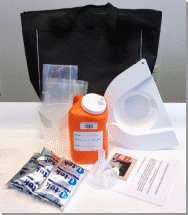
If you have questions or need to change your appointment, call the helpline at 1-888-XXX-XXXX.
Starting your urine collection:
After you leave our center today, please collect every drop of urine in the orange storage container every time you urinate (pee) in the next 24 hours.
You will take this urine collection kit to take home with you.
How to collect your urine while at home:
|
|
|
|
|
Do not collect your urine when you are on your period. If you are on your period, call us to re-schedule your day of collection. |
|
|
Insert picture container |
|
Insert picture container with fill line label |
|
|
|
How to collect your urine while away from home:
If you will be away from home during the 24-hour collection time, take the following items with you and continue to collect all your urine:
Black cooler bag
3 frozen ice packs
Empty orange container
Females - urine hat in Ziploc bag
Follow the instructions “How to collect your urine while at home”.
Keep the urine cold by storing the orange container in the cooler bag with ice packs.
Remember to always keep the orange container standing upright.
<<insert picture>>
Ending your urine collection:
On ______________(day, date) at ___________(time) plan to return to the urine mobile exam center to return your urine sample
Do not urinate (pee) right before your appointment because we will ask you to empty your bladder at the urine mobile exam center.
We will collect this last urine in your orange container and write the date and time of this last urine under the “End Time” on the container.
This ends the 24-hour urine collection.
Please bring back all the orange containers with urine in the black cooler bags with 3 frozen ice packs.
Return to the same location where you picked up your urine kit.
If you have any questions or need to change your appointment, please call us at 1-888-XXX-XXXX.
Instructions to Collect 24-Hour Urine
(Start/end collection at Home; all photos will be updated as new supplies are obtained;
Flesch-Kincaid Grade Level 6.0)
Thank you for participating in NHANES. Please be sure to read all the instructions.
The results will only be accurate if you follow the instructions and collect all your urine for a 24 hour period. It is very important that you collect every drop of urine during this 24 hour period. The information we obtain will help us learn about people’s nutrition. You will receive $100 when you bring your urine back.
Appointment to return your urine: _________________________

If you have questions or need to change your appointment, call us at 1-888-XXX-XXXX.
How to collect your urine while at home:
|
|
|
|
|
Do not collect your urine when you are on your period. If you are on your period, call us to re-schedule your day of collection. |
Insert picture of container |
|
Insert picture |
|
Insert picture of container with lid |
|
Insert picture with fill line |
|
How to collect your urine while away from home:
If you will be away from home during the 24-hour collection time, take the following items with you and continue to collect all your urine:
Black cooler bag
3 frozen ice packs
Empty orange container
Females - urine hat in Ziploc bag
Follow the instructions “How to collect your urine while at home”.
Keep the urine cold by storing the orange container in the cooler bag with ice packs.
Remember to always keep the orange container standing upright.
Start your urine collection on the morning of__________ (day, date).
When you wake up, urinate (pee) in the toilet as usual.
Do Not collect this urine
This is the start time of your collection.
Write this date and time on the label of all the orange containers – this is your start date and time.
Collect your urine every time you urinate (pee). If you have to get up during the night to urinate (pee), be sure to collect that urine too.
On __________(day, date), set your alarm to get up at the same time as the start time you wrote on your label.
If you get up during the night to urinate (pee), be sure to collect that urine.
Collect your first urine after you wake up. This is the last urine you will collect.
Write down the date and time of this last urine on the label. This is your end date and time.
Please bring back all the orange containers with urine in the black cooler bags with 3 frozen ice packs.
Return to the same location where you picked up your urine kit.
If you have any questions or need to change your appointment, please call us at 1-800-XXX-XXXX.
Attachment D
Verbal Urine Collection Instructions
Talking Points: starting 24-hr collection in the Urine MEC
Thank you for participating in NHANES. Please be sure to read all the instructions.
The results will only be accurate if you follow the instructions and collect all your urine for a 24 hour period. It is very important that you collect every drop of urine during this 24 hour period. The information we obtain will help us learn about people’s nutrition. You will receive $100 when you bring your urine back.
INSTRUCTIONS
We will ask you to empty your bladder today before you leave today.
We will write down the date and time of this first urine on the label, under the line “Start Date” and “Start Time”.
You will receive a urine collection kit to take home with you.
(Follow written directions to instruct participant to collect their urine.)
IMPORTANT THINGS TO REMEMBER
Collect all your urine every time you urinate during the 24 hour period, from _____ (day of week) to ________ (day of week).
If you get up during the night, be sure to collect that urine too.
It is very important that you collect every drop of urine and try not to spill any.
When you arrive at home, place all the ice packs from your urine kit in your refrigerator freezer.
If you stop somewhere before you get home today, remember to collect that urine.
Keep the urine kit near the toilet to remind you to collect your urine.
Do not fill past the black, “do not fill past here” line (show line on container). When it reaches this line use a new container the next time you urinate. It’s alright if the urine is a little over or under the line.
Keep the lid on tightly.
You do not need to fill the containers. Only fill with what you normally urinate (pee).
Keep your collected urine cold.
If you need to pass stool (poop), urinate and collect your urine first.
Females
Be sure the urine hat is positioned correctly before you start to urinate so that you collect all of the urine.
Put the toilet paper in the toilet. Do not put paper in the urine hat.
Do not collect when you are on your period. If you start your period, call us to reschedule your day of collection.
When you are away from home
If you will be away from home during the 24-hour collection time, take the urine kit with you and continue to collect all your urine:
Follow instructions on how to collect the urine.
Put the storage container into a Ziplock bag, seal the bag.
Always keep the container upright so the urine does not spill.
Keep your urine cold by storing the container in the cooler bag with ice packs.
Ending the urine collection
Ending collection at the UMEC:
On __________ (DAY of WEEK) at ________ (TIME), return to the urine mobile exam center to return your urine sample.
Do not urinate (pee) right before your appointment because we will ask you to empty your bladder at the urine mobile exam center to end the 24-hour urine collection.
If you have any questions, please call us at 1-XXX-XXX-XXXX.
Ending collection at home (when participant cannot return to the UMEC 24 hours later to end the collection)
On __________ (DAY of WEEK), collect your urine until ____________ (time).
This is the last urine you will collect.
Write down the date and time of your last urine collection on the label under “End Time”.
Return your containers with urine at the time of your appointment: _________________ (day, date, time).
If you have any questions, please call us at 1-XXX-XXX-XXXX.
Talking Points: starting 24-hour collection in the home
Thank you for participating in NHANES. Please be sure to read all the instructions.
The results will only be accurate if you follow the instructions and collect all your urine for a 24 hour period. It is very important that you collect every drop of urine during this 24 hour period. The information we obtain will help us learn about people’s nutrition. You will receive $100 when you bring your urine back.
INSTRUCTIONS
You will start your collection on _____________ (day of week and date).
You will collect all your urine for 24 hours.
It is very important that you collect every drop of urine and try not to spill any.
(Follow written directions to instruct participant to collect their urine.)
IMPORTANT THINGS TO REMEMBER
Collect all your urine each time you urinate during the 24-hour time period, from ____ (day of week) morning, to _____ (day of week) morning.
If you get up during the night to urinate (pee), be sure to collect that urine too.
It is very important that you collect every drop of urine and try not to spill any.
The night before you start collecting your urine, put all the ice packs in your refrigerator freezer overnight (or at least 6 hours) before collecting the urine.
Have the urine collection kit near the toilet to be ready to be used the next morning.
On ________ (DAY of WEEK), when you wake up, urinate (pee) in the toilet as usual. DO NOT collect this urine.
WRITE down the date and time of this first urine of the day on the label, under the line “Start Time”.
Begin to collect your urine the second time you urinate (pee).
Do not fill past the black “do not fill past here” line (show line on container). When it reaches this line use a new container the next time you urinate. It’s alright if the urine is a little over or under the line.
You do not need to fill up the containers. Only fill with what you normally urinate (pee).
Keep the lid on tightly.
Keep your collected urine cold.
If you need to pass stool (poop), urine and collect your urine first.
Eat and drink as you normally do.
Females
Be sure the urine hat is positioned correctly before you start to urinate so that you collect all of the urine.
Put the toilet paper in the toilet. Do not put paper in the urine hat.
Do not collect when you are on your period. If you start your period, call us to reschedule your day of collection.
When you are away from home
If you will be away from home during the 24-hour collection time, take the urine kit with you and continue to collect all your urine:
Follow instructions on how to collect the urine.
Put the storage container into a Ziplock bag, seal the bag.
Always keep the container upright so the urine does not spill.
Keep your urine cold by storing the container in the cooler bag with ice packs.
Ending the urine collection
On __________ (DAY of WEEK), plan to wake up at about the same time you woke up the day before on _______________ (day).
Collect your urine the first time you urinate. This is the last urine you will collect. Write down the date and time of this last urine on the label under “End Time”.
Return your containers with urine at the time of your appointment: ______ (DAY) at ____(TIME).
If you have any questions, please call us at 1-XXX-XXX-XXXX.
Attachment E
Completion Questionnaire
Completion Questionnaire
UCQ901-UCQ903 are completed based on Technician’s observation. Do not read the questions to the participants.
UCQ901. WAS THE TIME OF URINE COLLECTION RECORDED?
YES 1
NO 2 (Go to end of section)
UCQ902. WAS THE LENGTH OF THE COLLECTION TIME MORE THAN 22 HOURS?
YES 1
NO 2 (Go to end of section)
UCQ903. WAS THE TOTAL AMOUNT OF URINE COLLECTION MORE THAN 400 ML?
YES 1
NO 2
We would like to ask you several questions about your experience in collecting the urine for a 24 hour period. Your answers to these questions will not affect your payment.
UCQ001 (FOR FEMALES ONLY) Were you having your period at any time in the last 24 hours (during the 24 hours you collected your urine)?
YES 1
NO 2
REFUSED 7
DON'T KNOW 9
UCQ002. During the 24 hours, did you collect your urine every time you used the bathroom to urinate?
YES 1 (UCQ004)
NO 2
REFUSED 7 (UCQ004)
DON'T KNOW 9 (UCQ004)
UCQ003. How many times did you miss?
Interviewer instruction: Probe the amount of the void. Do not count as “miss” if the missed void was only a few drops.
|__|__| times
REFUSED 77
DON'T KNOW 99
UCQ004. Is there any urine missing from the storage containers for any other reason such as spilling?
YES 1
NO 2 (UCQ007)
REFUSED 7 (UCQ007)
DON'T KNOW 9 (UCQ007)
UCQ005. Were more than a few drops of urine lost?
YES 1
NO 2 (UCQ007)
REFUSED 7
DON'T KNOW 9
UCQ006. How many times did this happen?
|__|__| times
REFUSED 77
DON'T KNOW 99
UCQ007. Many people when having a bowel movement also urinate. Was there any time when you were not able to collect the complete urine sample because of a bowel movement?
Interviewer instruction: Probe the amount of the void. Do not count as “miss” if the missed void was only a few drops.
YES 1
NO 2 (UCQ009)
REFUSED 7 (UCQ009)
DON'T KNOW 9 (UCQ009)
UCQ008. How many times did this happen?
|__|__| times
REFUSED 77
DON'T KNOW 99
UCQ009. Were you able to keep the storage containers cold in the cooler with ice packs or in the refrigerator until this appointment?
YES 1 (UCQ011)
NO 2
REFUSED 7 (UCQ011)
DON'T KNOW 9 (UCQ011)
UCQ010. How long was the sample not kept cold?
|__|__| minutes/hour
REFUSED 7
DON'T KNOW 9
UCQ011. Did you perform this collection on a day that you also went to work?
YES 1
NO 2
DO NOT WORK 3
REFUSED 7
DON'T KNOW 9
UCQ012. When collecting the sample, did you have any difficulty in remembering or carrying out the instructions?
YES (specify_______) 1
NO 2
REFUSED 7
DON'T KNOW 9
UCQ013. Did you have any other problem when collecting the 24 hour urine sample?
YES (specify_______) 1
NO 2
REFUSED 7
DON'T KNOW 9
UCQ014. Did you eat or drink more or less than you normally do because you were collecting your urine?
Interviewer instruction: If SP ate or drank more for another reason, do not include.
YES (specify _____) 1
NO 2
REFUSED 7
DON'T KNOW 9
UCQ015. Is there any other liquid in the container besides your urine?
YES (specify_______) 1
NO 2
REFUSED 7
DON'T KNOW 9
Attachment F
Urine Sample Processing Procedure
Urine Sample Processing Procedure at the Urine MEC
Participants are asked to return to the UMEC to complete the urine collection, but if not possible, they are asked to bring the urine samples back to the UMEC within 48 hours of the start of collection. When the urine sample is returned to the UMEC, the following procedure will be used to process the urine:
Enter participant ID into the Completion Questionnaire application
If the start time and end time of the 24-hour collection was not recorded and cannot be ascertained, mark “2 – No” for UCQ901 in the Completion Questionnaire application. The system will mark the case as “Not Done” with comment “Participant failed to follow protocol”. The urine sample will not be processed or used.
If the length of collection time is <22 hours, mark “2 – No” for UCQ902 in Completion Questionnaire application. The system will mark the case as “Not Done” with comment “Participant failed to follow protocol”. The urine sample will not be processed or used.
If the total urine volume is less than 400 ml, the urine sample will not be processed or used. Mark “2 – No” in UCQ903. The system will mark the case as “Not Done” with comment “Participant failed to follow protocol”. However, the completion questions will be asked.
If UCQ901 and UCQ902 = 1, continue with the Completion Questionnaire. Continue with questionnaire if UCQ903=1 or 2.
Enter participant ID, start date/time and end date/time of the 24-hour collection into the lab application.
The application system will calculate the length of collection. Confirm the length of collection time to be at least 22 hours.
Label the individual containers numerically.
If the collection ended at the UMEC, remember that the final sample of urine voided is to be included in the 24-hour collection.
Record the weight of each container into the lab application.
Place each urine container on the scale to obtain the weight.
The weight reading will be entered into the lab application system.
The system will deduct the container weight from the recorded weight and calculate the actual weight of the urine. It will then convert the weight into the volume of the urine, using 1 gm = 1 ml, for the record.
The system will calculate the total volume for the 24-hour urine sample.
The application will include a drop down list of comment codes (same codes as used for the MEC urine collection module) for the urine sample.
Aliquot seven vials of urine samples from the 24-hour urine collection.
Pool all the urine from the containers into one large container.
Before taking sample from the urine container, thoroughly and gently mix the urine sample for at least 15 seconds.
Aliquot 10 ml of urine into one 14-ml cryovial (for sodium, potassium, chloride, creatinine, albumin, urea nitrogen).
Aliquot 4 ml of urine into one 5-ml cryovial (for calcium, oxalate, phosphorus).
Aliquot 5 ml of urine into one 5-ml cryovial (for iodine)
Aliquot 5 ml of urine into one 5-ml cryovial (for fluoride)
Aliquot 5 ml of urine into one 5-ml cryovial (for phytoestrogens, and caffeine metabolites)
Aliquot 5 ml of urine into three 5-ml cryovial and 10 ml of urine into one 10-ml cryovial (for tobacco markers).
Aliquot 2 vials of 5-ml urine into the 5-ml cryovials. These vials will be stored for additional tests.
Discard the remaining urine.
Store the aliquots in freezer.
Process the urine samples the same day they were received. Urine samples can be kept refrigerated at 4°C or less for no more than 24 hours.
All aliquots need to be shipped to the lab within 7 days. The aliquots need to be shipped frozen on dry ice.
Attachment G
NHANES Health Measurements List
U.S
DEPARTMENT OF HEALTH AND HUMAN SERVICES Centers
for Disease Control and Prevention National
Center for Health Statistics
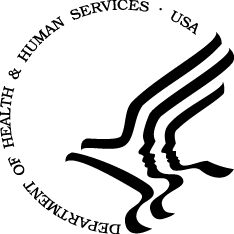

NHANES Health Measurements List
Below is a list of tests you will receive on the day of your examination.
You will only have the test if your age falls within the ages shown in parenthesis.
You will receive the results of health measures shown with a black diamond (♦). Two diamonds (♦♦) means you will receive the test result only if high or abnormal.
Health Measurements
You will be weighed and measured (all) ♦
The doctor will take your blood pressure (8+) ♦
We will look at the condition of your teeth and gums (1+) ♦
Dental imaging for fluorosis (6-19)
You will have body composition tests that involve low-dosage x-rays (Pregnant women will not have this test)
Total body scan (8-59) ♦
Hip and spine bone density scans (40+) ♦
You will have a taste and smell test (40+) ♦
You will have a grip strength test (6+) ♦
Private Interviews
You will be asked questions about your
eating habits (all)
You will be asked to answer questions about:
Weight history (8-15)
Reproductive history (females 12+)
Drug use (12-69), alcohol and tobacco use (12-19), self-identified stage of puberty (8-19) and sexual history (14-69)
(You will do these by yourself using a touch-screen computer in privacy)
You will be asked to take short tests to assess your learning and memory (60+)
Lab Tests on Urine (6+)
You will be given a clean empty cup when you arrive at the exam center. When you change into the exam clothes in a private rest room, you will provide a urine sample. The urine will be tested for:
Exposure to environmental chemicals and metals (all) [arsenic ♦♦]
Kidney function tests (all) ♦
Sexually transmitted diseases:
Chlamydia (14-39) ♦
Trichomonas (14-59) ♦
(Urine is not tested for drug use)
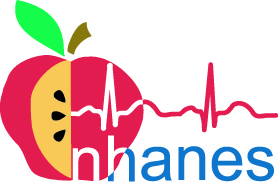
Please turn over to see the next page.
2013 NHANES Health Measurements, cont.
Lab Tests on Blood (1+)
You will have your blood drawn. The blood will be tested for:
Anemia (all) ♦
Nutrition status (all) ♦
Lead, cadmium, mercury, manganese
(all under 12, selected participants 12+) ♦
Selenium (6-11, selected participants 12+) ♦
Copper and zinc (6+) ♦
Infectious diseases (2+) ♦♦ Total Cholesterol/HDL (6+) ♦
Triglycerides/LDL (Morning session participants only, 12+) ♦
Exposure to environmental chemicals (selected participants 6+)
Kidney and liver function (12+) ♦
Markers of celiac disease (6+) ♦
Marker of muscle damage (12+) ♦
Caffeine (6+)
Testosterone (6+) ♦
Estradiol (6+)
Sex hormone binding globulin (6+)
Sexually transmitted diseases (STD):
Genital herpes (14-49) ♦
Human immunodeficiency virus (HIV) (18-59) ♦
Human Papillomavirus (HPV) (14-59)
Glucose (12+) ♦
Persons examined in the morning will have their blood drawn a second time to check for prediabetes
Fluoride (3-19) ♦
Lab Tests on Saliva
Human Papillomavirus (HPV) (14-69)
Women and girls only:
You will be asked to self-administer a vaginal swab in complete privacy. The swab will be tested for the presence of Human Papillomavirus (14-59) ♦
Females 12 years and older will have a urine
pregnancy test, as well as girls 8-11 who have started their periods. Our physician will tell you if you are pregnant if you did not already know it. Parents of
girls younger than 14 years of age who are pregnant will also be informed of the test result ♦♦
Men and boys only:
You will be asked to self-administer a penile swab in complete privacy. The swab will be tested for the presence of Human Papillomavirus (14-59).
Lab Tests on Water:
The interviewer will collect a sample of household tap water if participants are under 20 years of age. The water will be tested for fluoride. ♦
After your visit to the NHANES mobile center:
If you had a dietary interview as part of your exam, you will get a phone call 3-10 days after the exam to be asked similar questions.
You will be asked to provide two additional urine samples (ages 20 - 69). Before leaving the center, you will be given instructions, two clean empty cups, and a prepaid, addressed box for shipment to our lab.
You will be asked to wear a physical activity monitor for 7 days after your exam (ages 3 years and older). A prepaid envelope will be provided for mailing the monitor back to our headquarters.
Select persons (ages 20-69) will be asked to collect their urine for 24 hours.
Taking part in these interviews and health measures after your visit to the mobile center is voluntary.
If you have questions about getting your results, please call 1-800-452-6115
| File Type | application/vnd.openxmlformats-officedocument.wordprocessingml.document |
| File Title | CDC INSTITUTIONAL REVIEW BOARD (IRB) |
| Author | vlt0 |
| File Modified | 0000-00-00 |
| File Created | 2021-01-28 |
© 2026 OMB.report | Privacy Policy
